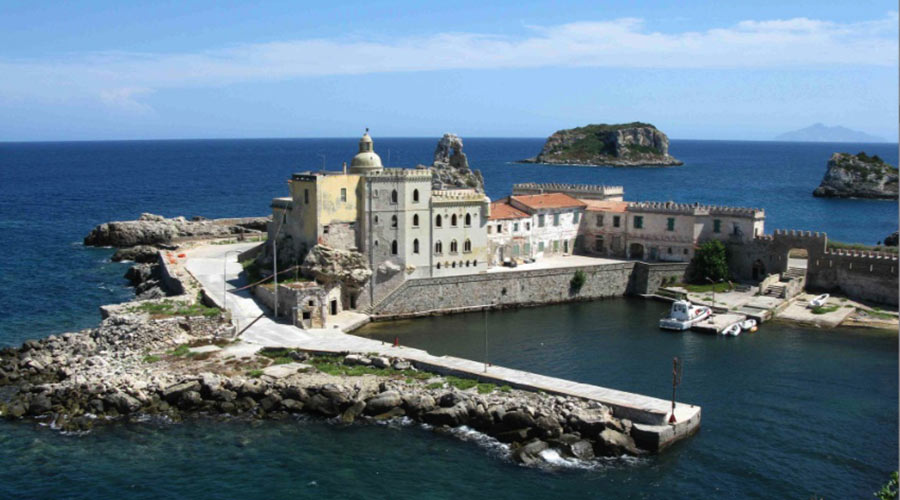Isola di Pianosa
Protetta dal carcere per 142 anni, la colonia penale realizzata nel XIX secolo era stata trasformata in carcere di massima sicurezza con conseguente divieto di sbarco se non con un permesso speciale del Ministero degli Interni o per fondati motivi dovuti alla navigazione, come avaria di bordo o mare grosso.
Nel 2011, il carcere ha cessato le attività d'istituto ed è terminato il divieto assoluto di sbarco che aveva impedito il turismo sull'isola.
Nella ex residenza del direttore del carcere č stato realizzato un piccolo hotel, dove possono alloggiare pochi turisti, gestito da alcuni volontari e da detenuti in regime di semilibertŕ del carcere di Porto Azzurro che insieme ai volontari stessi, costituiscono la popolazione dell'isola.
I turisti, in numero limitato, possono raggiungere l'isola, ed eventualmente soggiornare in hotel, con un traghetto che parte ogni mattina dall'Isola d'Elba ed effettua la corsa di ritorno ogni sera.
L’isola “piatta” è una risorsa unica: praterie di Posidonia vera e propria “nursery” della fauna ittica dell’alto Tirreno, le catacombe più importanti a nord di Roma, la Villa Romana di Agrippa, il Sanatorio di Punta Marchese dove fu confinato anche Sandro Pertini, una flora e una fauna caratterizzate da molteplici rarità dovute ad un’evoluzione “in isolamento” e un eccezionale flusso migratorio.
Non trascuriamo, fra l’altro, le potenzialità rappresentate delle strutture del carcere, intese come “monumento” moderno della storia del nostro paese che va dai briganti della Maremma ai prigionieri austriaci per arrivare agli anni di Piombo e alle stragi di mafia.
Lo stesso muro che divide in due l’isola, costruito nel ’78 può certo rappresentare una testimonianza “storica” da valorizzare. Nella parte purtroppo chiusa, si trovano le baie e scogliere tra le più belle di tutto l’Arcipelago Toscano.
Pianosa è anche la sola delle isole toscane ad essere formata interamente da rocce sedimentarie.
Data la natura calcarea e il carattere pianeggiante del territorio, è stata coltivata fin dai tempi più antichi.
Apparteneva anch’essa ai Romani e Augusto vi relegň il nipote Postumio Marco Giulio Agrippa, che vi fu ucciso.
Nella cala di S. Giovanni si possono vedere ancora oggi i ruderi della Villa Romana di Agrippa.
L’isola, malgrado la sua costa aspra e inospitale, irta di rocce e spaccature, cambia poi totalmente paesaggio, assume a poco a poco, un aspetto pianeggiante e tranquillo. cactus, ulivi, agave, si inseriscono dolcemente in questo pezzo di terra mite di clima e di colori, che con i suoi campi coltivati a grano e orzo, colmi di assolato silenzio, ci riporta ad una immagine di vita campestre.
I fondali intorno all'isola sono bassi e si approfondiscono dolcemente, la batimetrica dei -50 viene raggiunta in media a circa 1500 m dalla costa. L'isola è interamente compresa nel Parco Nazionale dell'Arcipelago Toscano ( http://www.islepark.it ).
Attorno all'isola, nel raggio di 1 miglio sono vietati navigazione e pesca. L'accesso č demandato ad un permesso rilasciato dalla Direzione del Parco.
| Regione |
Toscana |
| Zona |
Isola di Pianosa |
| Comune |
Campo nell'Elba |
| Provincia |
LI |
| Superficie |
10,3 km² |
| Abitanti |
10 |
| Coordinate GPS |
2°35′N 10°05′E |
Numeri utili
| Pronto Soccorso |
Tel. 118 |
| Emergenza in Mare |
Tel. 1530 |
| Guardia Medica |
Tel. 118 |
| Polizia di Stato |
Tel. 113 |
| Carabinieri |
Tel. 112 |
| Vigili del Fuoco |
Tel. 115 |
| Polizia Stradale |
Tel. 113 |
Ottieni indicazioni stradali partendo da:
COME ARRIVARE
I turisti, in numero limitato, possono raggiungere l'isola con un traghetto che parte ogni mattina dall'Isola d'Elba ed effettua la corsa di ritorno ogni sera ed eventualmente soggiornare in un piccolo hotel realizzato nella ex residenza del direttore del carcere.



